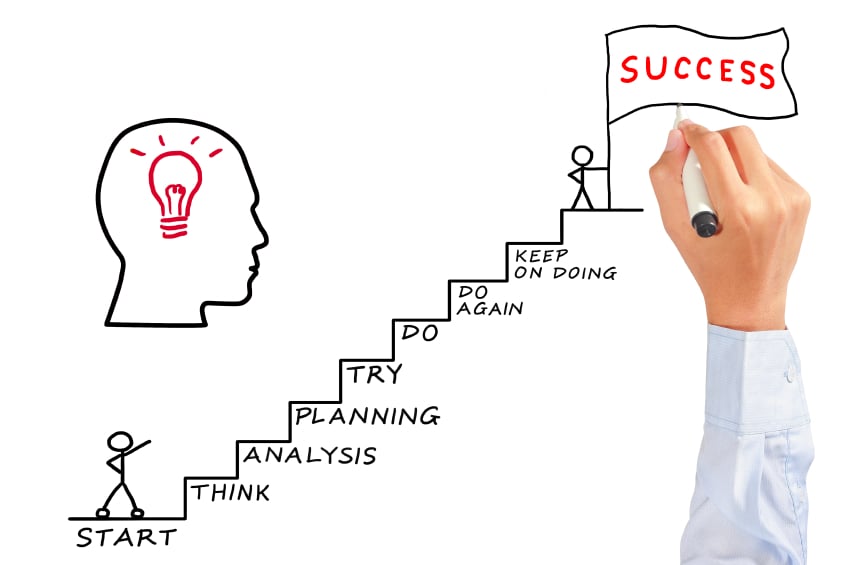The 7 Steps to Inbound Marketing Success: Step 1 Plan
As an inbound marketing consultant, I have the pleasure of working each day with companies across a variety of industries to create and improve...

The 7-Step Lead Generation process that LeadG2 uses to help clients navigate and embrace an inbound marketing culture is a road map that can be used by companies at any phase of their inbound marketing efforts. It’s not just for use during the planning process and one of the best ways to use these seven steps is to analyze your current inbound marketing initiative and determine how you are doing with each of the Seven steps.
Over the next few weeks we are going to take a look at each of the 7 steps in Generation process and offer some tips and tricks at each stage. We hope that by detailing each step in the process it can help clarify the steps needed for inbound marketing success. Below is the 7-Step Lead Generation process that LeadG2 uses to help clients navigate and embrace an inbound marketing culture. Over the next few weeks we are going to take a look at each stage of the 7 Step Lead Generation process and offer some tips and tricks at each stage. We hope that by detailing each step in the process it can help clarify the steps needed for inbound marketing success.
In our first post, we addressed Step 1 in the Inbound Planning Process, Plan. During our day long, inbound planning day where we work with clients to establish an inbound culture and provide a strategy that can be either carried out by the client or by a marketing agency such as LeadG2. Step 2, in the Seven Step Lead Generation process which we will be addressing in this blog post is “Create.”
The second step, “Create” is sometimes one of the most challenging aspects of inbound marketing and embracing an inbound culture. Why is this so challenging for companies to grasp? Well, to start with for most companies content marketing is a new way of doing things, and it takes a fair amount of education and understanding to truly see the potential and how it can fundamentally change the way a company markets themselves.
Also, as content marketing is new to most companies there are not many internal resources to guide the efforts and to ensure best practices are being followed and content is being created in the most efficient way. For many new inbound marketers, this is their first foray into blogging, creating white papers and distributing content via social media. This is why companies with limited internal resources are best to find freelancers or a marketing agency to help.
In Step 1, Plan we discussed the importance of getting your team together and coming up with a long list of premium content and blog posts to support them. The brainstorming process will provide you with a number of great ideas for premium content and blogs. It’s very important to then narrow them down to ideas that would not only resonate with your target persona but also align with your products and services. Remember, the primary goal of content marketing is to generate leads and increase revenue and not just come up with blog posts and premium content. We have seen all too often that companies have some great blog post ideas but when asked how they tie back to the companies products and services there is no linkage. As a result, be sure to spend most of your time creating content that is not just interesting to your target persona but also relevant. If you don’t sell widgets, you shouldn’t be blogging and creating content about widgets.
TIP: Your content doesn’t always have to be a blog post or a whitepaper. It‘s best to embrace the concept of target personas and create content that resonates with your target audience. If your target persona would be more interested in videos or infographics then spending your time on those content areas makes more sense.
Here’s a list of different types of premium content offers:
After it’s determined what you are going to create, it’s important that you have someone designated as the person who will be responsible for making this happen. In most cases this will be the person that we have designated the “Blog Manager.” It’s the Blog Manager’s responsibility to determine if the content will be produced internally or created with the help of a marketing agency or a team of freelancers. Regardless of how the content is produced and who produces it, the most important things to focus on are making sure it’s something your target persona would be interested in, is professional looking, and is created within your budget.
TIP: Content mapping is a great way to create a linkage between the premium content you are creating and blog posts that are used to promote them. For each “offer” that you create you will want to have at least 5 - 10 blog posts that can tie back to the offer. So if you had a “Download a Sample Widget” as an offer you would want to have several blog posts about “Why Widgets Matter,” “Top 5 Greatest Things about Widgets,” and so forth.
Determining your content strategy is one of the most important things that you can do while mapping out your content strategy as 54% of companies surveyed by Ascend2 said that “content creation is not only the most effective tactic for Inbound Marketing purposes, it is also the most difficult tactic to execute.”
So far we have looked at the importance that the development of an inbound strategy plays in the success of inbound marketing efforts, and in this post how to create content that’s relevant to your target audience. The next step, Step 3: Distribute, is one that we see companies under-emphasizing and expect that “if they build it, they will come.” This is one of the myths of content marketing, that by creating content you will automatically become thought leaders and increase traffic to your website. Trust me, this doesn’t happen automatically and some content marketers go as far as saying that you need to spend less time creating content and more time promoting them.
Step 3: “Distribute” will be addressed in the next blog post and will get into more detail about how to use social media and other methods to amplify your messages. Having a solid social media strategy is crucial to the success of any company engaging in content marketing. Stay tuned and make sure that you subscribe to the blog so you can be notified when the next one is published.

As an inbound marketing consultant, I have the pleasure of working each day with companies across a variety of industries to create and improve...

Each of the steps in LeadG2’s 7 Step Lead Generation Process is extremely important to the overall success of your inbound marketing efforts. We have...
Over the past few weeks we have been taking a look at each of the 7 steps in the lead generation process that we use to help clients navigate and...